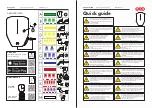
Accordingly, when the low tire pressure telltale
illuminates, you should stop and check your tires as soon
as possible, and inflate them to the proper pressure.
Driving on a significantly under-inflated tire causes the
tire to overheat and can lead to tire failure. Under-inflation
also reduces fuel efficiency and tire tread life, and may
affect the vehicle’s handling and stopping ability.
Please note that the TPMS is not a substitute for proper
tire maintenance, and it is the driver’s responsibility to
maintain correct tire pressure, even if under-inflation has
not reached the level to trigger illumination of the
TPMS low tire pressure telltale.
Your vehicle has also been equipped with a TPMS
malfunction indicator to indicate when the system is not
operating properly. The TPMS malfunction indicator is
combined with the low tire pressure telltale. When the
system detects a malfunction, the telltale will flash
for approximately one minute and then remain
continuously illuminated. This sequence will continue
upon subsequent vehicle start-ups as long as the
malfunction exists.
When the malfunction indicator is illuminated, the system
may not be able to detect or signal low tire pressure as
intended. TPMS malfunctions may occur for a variety of
reasons, including the installation of replacement or
alternate tires or wheels on the vehicle that prevent the
TPMS from functioning properly. Always check the TPMS
malfunction telltale after replacing one or more tires or
wheels on your vehicle to ensure that the replacement or
alternate tires and wheels allow the TPMS to continue to
function properly.
See Tire Pressure Monitor Operation on page 5-69 for
additional information.
Federal Communications Commission
(FCC) and Industry and Science Canada
The Tire Pressure Monitor System (TPMS) operates
on a radio frequency and complies with Part 15 of
the FCC Rules. Operation is subject to the following
two conditions:
1. This device may not cause harmful interference.
2. This device must accept any interference received,
including interference that may cause undesired
operation.
The TPMS operates on a radio frequency and complies
with RSS-210 of Industry and Science Canada.
Operation is subject to the following two conditions:
1. This device may not cause interference.
2. This device must accept any interference received,
including interference that may cause undesired
operation of the device.
Changes or modifications to this system by other than
an authorized service facility could void authorization to
use this equipment.
5-68
Содержание 2009 9-7X
Страница 72: ... NOTES 1 68 ...
Страница 120: ... NOTES 2 48 ...
Страница 123: ... NOTES 3 3 ...
Страница 124: ...Instrument Panel Overview 3 4 ...
Страница 220: ... NOTES 3 100 ...
Страница 272: ...Engine Compartment Overview When you open the hood on the 4 2L L6 engine here is what you will see 5 12 ...
Страница 274: ...When you open the hood on the 5 3L V8 engine here is what you will see 5 14 ...
Страница 276: ...When you open the hood on the 6 0L V8 engine here is what you will see 5 16 ...
Страница 389: ...Engine Drive Belt Routing 4 2L L6 Engine 5 3L V8 and 6 0L V8 Engines 6 15 ...
Страница 391: ...Maintenance Record cont d Date Odometer Reading Serviced By Maintenance I or Maintenance II Services Performed 6 17 ...
Страница 392: ...Maintenance Record cont d Date Odometer Reading Serviced By Maintenance I or Maintenance II Services Performed 6 18 ...
Страница 410: ... NOTES 7 18 ...
















































